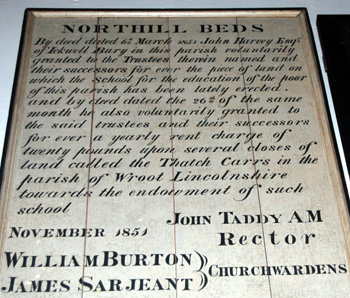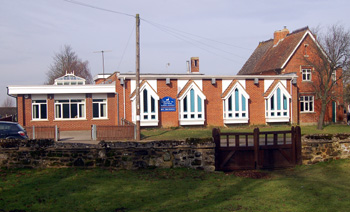Northill School

Northill school board in the west tower May 2010
Northill National School was created in 1855, the site having been acquired four years earlier thanks to a donation of land by John Harvey of Ickwell Bury. A board in the west tower of Northill Church [see above] reads: "By deed dated 6th March 1851 John Harvey Esq. of Ickwell Bury in this parish voluntarily granted to the Trustees therein named and their successors for ever the piece of land on which the School for the education of the poor of this parish has been lately erected and by deed dated the 26th of the same month he also voluntarily granted to the said trustees ad their successors for ever a yearly rent charge of twenty pounds upon several closes of land called the Thatch Carrs in the parish of Wroot, Lincolnshire towards the endowment of such school".
![Northill School rules [P10/29/1/1]](/CommunityHistories/Northill/NorthillImages/Northill School rules [P10-29-1-1]_173x299.JPG)
Northill School rules [P10/29/1/1]
The rules are [shown above - P10/29/1/1] and logbooks survive from 1863 going through to 1976 [SDNorthill1/1-3]. The rules were as follows:
I.
The School is open to all Inhabitants of the Parish at the following rates of payment, -
1. Labourers 2d. per week for one child, 1d. for all after.
2. Farmers or tradesmen 6d. per week for one child, 4d. for all after.
N. B. Special agreement may be made with Parents when any peculiar circumstances seem to require it.
All payments to be made in advance, either on the Monday in each week for that week, or on the first Monday in each quarter for the quarter.
II.
All scholars to be in attendance punctually at nine and two o'clockeach day except Saturday. Notice must be sent to the Master of absence on account of illness, and leave must be asked in case of unavoidable absence from any other cause.
Prizes will be given at the end of the year for regular attendance and good conduct.
III.
A Clothing Club will be provided for the scholars. Any scholar paying a weekly sum into the club will (before Christmas each year) receive a ticket for clothing to the amount of such deposit, together with such addition as the funds will allow.
IV.
Scholars must purchase copy-books and other articles necessary for home lessons, which are supplied at the School at a low rate of charge.
![Plan of the National School [AD3865/32/3]](/CommunityHistories/Northill/NorthillImages/AD3865-32-2.JPG)
Plan of the National School [AD3865/32/3]
In 1869 the rector agreed with local builder Henry Field to pull down the existing buildings and build a new school according to accompanying plans [AD3865]. The first Education Act was passed in 1870 (more correctly it was known as the Elementary Education Act). It was a milestone in the provision of education in Britain demonstrating central government's unequivocal support for education of all classes across the country. It also sought to secularise education by allowing the creation of School Boards. These were groups of representatives, elected by the local ratepayers and the Board had the powers to raise funds to form a local rate to support local education, build and run schools, pay the fees of the poorest children, make local school attendance compulsory between the ages of 5 and 13 and could even support local church schools, though in practice they replaced them, turning them into Board run schools (known as Board Schools). Naturally, and luckily for local historians, the Act required a questionnaire of local schools in 1870. The questionnaire for Northill recorded the existing NationalSchool with accommodation for 141 children. No School Board was ever formed in Northill, the school remaining a NationalSchool until the next great Education Act.
The School log books provide an interesting glimpse of Victorian life in a small village school and the effect of earning a living on school attendance [SDNorthill1/1]:
- 17th July 1871: Attendance small, onion peeling began.
- 28th June 1872: A fresh sphere of Agriculture opened for young children, viz. hay making. This is the first year children have been thus employed.
- 5th July 1872: Children away Turnip threshing.
![Elevation of the National School [AD3865/32/3]](/CommunityHistories/Northill/NorthillImages/AD3865-32-3_350x239.JPG)
Elevation of the National School [AD3865/32/3]
A land mark Education Act was passed in 1902, coming into effect in 1903. It disbanded the School Boards and gave day to day running of education to newly formed Local Education Authorities, usually the county council, as in Bedfordshire. The old Board Schools thus became Council Schools whilst the old National, British and other non-Board schools became known as Public Elementary Schools. Northill National School duly became Northill Public Elementary School.
Bedfordshire & Luton Archives & Records Service has a scrapbook of cuttings of visits made to most Bedfordshire Schools by School Inspectors for a period from just before the First World War through the inter-war years [E/IN1/1]. The first report dates to 1911, when average attendance was 109 and noted: "The older scholars are in good order and their attainments are fairly satisfactory
... points requiring attention are the arithmetic of the upper part of the first class, the singing of the same class, the composition and arithmetic of the middle group and the reading of the lowest. The condition of the Infants' Division is, on the whole, fairly satisfactory, but the reading of the First Class leaves a good deal to be desired". In 1913 no changes to the junior department were noted except an improvement in PE, overall it was noted: "The children, especially of those of the lower divisions and of the Infants' Class speak indistinctly".
The first report after the Great War, in 1919, was not encouraging: "A visit on 30th October last [1918], shewed that in certain respects the work of the school was unsatisfactory. Since that date one of the assistant teachers has left. It is creditable that this has not led to a further falling off in the 3 Rs, indeed there is evidence of pains having been taken to rectify defects in the written work that were noticed at the former visit. There is still much to be done to put the work of the Mixed Division on a satisfactory footing. Especially the Physical Exercises, Singing, Drawing and Oral Subjects must be taken in hand. I the Infants' Division, though there is no falling off at present and Reading has improved, it is clear that further assistance is rquired. If this cannot be obtained children under 5 years of age should not be admitted". No great improvement was noted in the next inspection, in 1922.
It was not just the teaching that merited concern. In 1925 the buildings were inspected and the report noted: "Both heating and cloakrooms are inadequate: the boys' washing arrangements are in a shed which is rotting away. the playground surface is rough and the water cannot drain away from it or from the boys' urinal. Both the offices are cesspits at present and should be reconstructed as water closets".
Things at the school remained poor in 1926, the report noting: "The chief characteristic of the School, which is far from inefficient, is want of life and alertness. The lowest group, Infants and Standard I, are working on a Time table which does not provide for Standard I. the Teacher is not clever at keeping all the groups occupied, and they are shy and slow of speech. The top group say recitation without expression or enjoyment, are slow at attempting commonsense sums, and in Physical Training are inclined to stamp when marching; and, as a word of command is not well given, there is not much vigour in the exercises". Even the girls' needlework was sloppy: "The girls were slow in response, and were particularly sloe at reckoning the relative proportions of garments according to any given measure".
In 1927 the parish, including the school buildings, was visited by a valuer and all buildings and land valued in accordance with the 1925 Rating Valuation Act. The valuer found [DV1/C/4] that the Voluntary School was built of brick and tile and was "good"; it had a large class room, small class room, three cloak rooms and a book room, boys' earth closets, girls' earth closets, boys' urinal, washhouse, coal barn and accommodation for about 135. He further noted: "School supported by endowments, grant from Government towards repairs and County Council pays teachers"
However, by the next year things were a little brighter: "The criticisms of the last report on the work of this school, in so far as they refer to matters of organisation, aims and methods, have received attention…A good feature is the very thorough way that the work in all subjects is periodically tested and critical reports made in the record books. A promising start has been made in the new handwork scheme of Light Woodwork for the senior boys and Cardboard work for the juniors. Other possible developments, such as the elaboration of the school scheme, the introduction of private study methods with the seniors and the establishment of a team system, were discussed with the Head Master during the inspection".
The last report is for 1934, when average attendance was down to 43 because "This School has become a Junior School since the date of the last report. It is conducted in two classes, Standards II, III and IV under the Head Mistress, and Standard I and Infants under a Supplementary Teacher. It is understood that the latter had many years experience with children of 3 and 4 years of age; she is exceedingly kind and pelasant, but cannot as yet manage the higher groups…the older children are in much better care than this…The new desks and redecoration of the school have made a great improvement in brightness in the building".
The third of the great Education Acts was that of 1944 which established the principle of County Primary Schools for children up to the age of 11, at which time they took an examination to determine the nature of the secondary school they would attend until they were 15, the most academically able going to grammar schools, the rest to secondary or secondary modern schools. The act also created two types of successor to the public elementary schools - the Voluntary Aided and Voluntary Controlled schools. Voluntary Aided schools are those in which the Local Education Authority funds the school but the governing body is independent. Voluntary Controlled schools own their own buildings whilst the staff are employed directly by the governors. Northill Public Elementary School became Northill Voluntary Aided County Primary School.
In the 1970s Bedfordshire County Council introduced comprehensive education, doing away with the 11+ examination and grammar schools and introducing a tier of school between the old County Primary and County Secondary Schools. Thus Lower Schools now taught children aged 4 to 9, Middle Schools from 9 to 13 and Upper Schools from 13 onwards. Northill school duly became Northill Voluntary Aided Lower School; it continues [as of 2007] to occupy the 1869 buildings near the church, albeit with modern additions. The school was later renamed Northill Church of England Voluntary Aided Lower School
 Northill Church of England Voluntary Aided Lower School March 2010
Northill Church of England Voluntary Aided Lower School March 2010